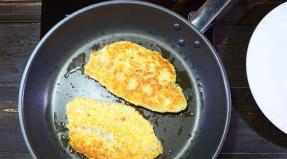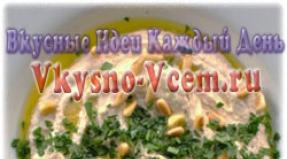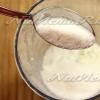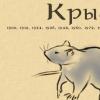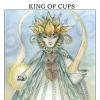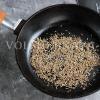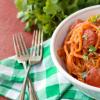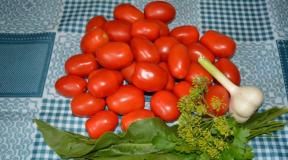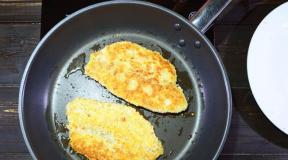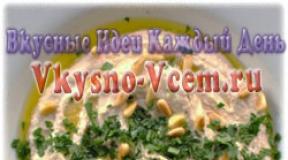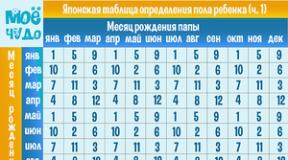How many calories are in borscht with water without meat? How many calories are in a plate of borscht (with and without meat)
The name of this thick vegetable soup, the main ingredient of which is beets, presumably comes from the Old Slavonic “burshch”, which meant hogweed - an edible herb, the leaves of which were used in cooking. Later it was transformed into the word “borscht”. The calorie content of this dish depends on several factors: first of all, on whether the borscht is prepared with meat or vegetable broth.
Traditionally, borscht is considered Ukrainian. However, this is not entirely correct: in one form or another it is present in Russian, Belarusian, Polish, and even Moldavian and Lithuanian cuisines. It has many cooking options - almost every region has its own secrets.
Ukrainian cooks traditionally seasoned borscht with a mixture of crushed lard and garlic. Moscow borscht, according to the recipe, should be cooked in addition, shortly before the end of cooking, finely chopped ham is added to it. Starolitovsky borscht is boiled with bones, seasoned fried and served with porcini mushrooms. Moldavian borscht is prepared using chicken broth, seasoned with vegetables fried in chicken fat. The calorie content of these first courses, as is clear from their description, will differ significantly from the calorie content of vegetarian, or “lenten” borscht, which is often prepared by modern housewives.
100 g of borscht cooked with vegetable broth contains no more than 50 kcal. If you add beans to it, the calorie content will increase to 68 kcal/100 g. As for meat-based borscht, this figure is much higher. Thus, the calorie content of borscht with lard is 98 kcal, borscht with porcini mushrooms and prunes is 109 kcal. 100 g of Moscow-style borscht contains 115.5 kcal, and 119 kcal when cooked in bone broth.
Any type of this dish seasoned with sour cream becomes about 15-20 kcal more caloric. Therefore, the answers to the question of how many calories are in borscht will be different, depending on the characteristics of the preparation of one or another version of it and the products used in it. If necessary, you can determine the calorie content of borscht, like any dish, by calculating the calorie content in its ingredients based on their weight. Since correctly counting calories manually is quite a troublesome task, you can use special online programs for this, which are available on some culinary sites.
However, the caloric content of dishes is not all that lovers need to take into account. healthy image life. Any broth, even one made from lean dietary meat (and most of all bone broth), poses a potential danger for those who have uric acid metabolism disorders. It is important for such patients to avoid foods containing purines, in particular red meat, organ meats, fish, certain types of vegetables (tomatoes, legumes, sorrel and spinach, Brussels sprouts and cauliflower), and mushrooms. When cooking meat and fish, up to 50% of the purines they contain are released into the broth. When they enter the body in large quantities, they can provoke the development of a serious and unpleasant disease - gout, in which uric acid crystals are deposited in the joints. It is formed in the body precisely from purines, so for those who care about their health, it makes sense to prepare vegetarian borscht. Its calorie content is low, but the benefits are quite noticeable.
Lenten borscht cooked according to the rules contains several types of vegetables that enrich the body with mineral salts and vitamins. In addition, the fiber they contain effectively cleanses the intestines of harmful substances - toxins, nitrates, radionuclides. The ingredients of borscht, in particular beets, have a choleretic effect, so this dish is indicated for cholecystitis and At the same time, the juice effect of vegetable decoctions can harm patients with chronic pancreatitis, causing an exacerbation of the disease. For gastritis with high acidity, borscht should also be excluded from the menu - its calorie content does not matter. In general, those who have diseases of the gastrointestinal tract should consume this dish, prepared either in meat or bone broth, or in a vegetarian version, with caution.
4.7 out of 5The most popular first course among residents of Ukraine and Russia is borscht. There is an opinion that every housewife should be able to cook this dish. Currently, there are many options for preparing this soup, as well as its varieties. Depending on this, the calorie content of borscht may vary.
Types of borscht
All types of borscht are conventionally divided into two groups: red and green. Red contains beans, meat, tomatoes, beets, cabbage, potatoes and onions. Of course, it is impossible to imagine real aromatic and hot Ukrainian borscht without a spoon of sour cream.
The main ingredients of green borscht are potatoes, sorrel, meat, onions, carrots and herbs. This dish in itself has a rich taste, but it can be supplemented with sour cream and a boiled egg. It is important not only to know how many calories are in borscht, but also to understand that it contains many vitamins, such as C, B6, B2, B1, as well as pantothenic and folic acid. In addition, borscht is rich in minerals, so it provides the necessary vital energy, normalizes the functioning of the liver and digestive system, and enriches the body with missing useful elements. So, how many calories are in borscht?
Calorie content of borscht
Borscht is one of the hearty first courses because, as a rule, it is cooked in fatty meat broth. The number of calories depends on the recipe according to which it is prepared. First of all, you should pay attention to the ingredients included in the dish. Knowing them, you can easily calculate the calorie content of borscht.
Let's consider the number of calories in borscht of one type or another.. Thus, a 100-gram portion prepared according to the traditional Ukrainian recipe, contains about 100 kcal. The calorie content of borscht with fresh cabbage does not exceed 117 kcal, with sauerkraut – 156 kcal. The lowest calorie content of borscht with beans is 100 grams. finished product contains no more than 67 kcal.
If you are striving for ideal figure, but don’t want to give up borscht, give preference to the least high-calorie versions of this soup. By the way, nutritionists advise eating slightly warm borscht - this will naturally reduce its calorie content.
How to reduce the calorie content of borscht

Reducing the calorie content of borscht is quite simple. Of course, the safest thing for your figure is soup cooked in water. Borscht cooked with bones or pork will, accordingly, have the most calories. The average amount of calories is contained in borscht cooked in chicken or beef broth. The recipe for Ukrainian borscht involves pre-frying vegetables. It is also worth considering that sour cream is added to it. Of course, all this increases the calorie content of borscht.
Adherents of healthy eating decide this problem as follows: they refuse to sauté onions, beets and carrots in vegetable oil and fat. Instead, they throw vegetables into a pot of boiling water, as a result of which they do not feel heavy even after a large portion of borscht.
Remember that beans can be an excellent substitute for potatoes. As for sour cream, you can replace heavy cream with a low-fat version - this will not affect the taste of the finished dish. Borscht is low in calories, so you can treat yourself to it several times a week, and your figure will not suffer.
How to cook borscht
To prepare borscht, you need the following ingredients: broth, onions, carrots, cabbage, potatoes, herbs and tomato paste. First of all, you need to bring the broth to a boil, then add raw beets to it (pre-cut into large slices). Boil it for 15 minutes and add boiled meat and all the vegetables needed for borscht to the liquid. Once the cabbage and potatoes are fully cooked, place the pan on another burner and remove the beets from the borscht. When the vegetable has cooled, grate it on a fine grater and place it in a pan with the ready-made soup.
This method of preparing beets allows you to preserve all the vitamins and beneficial features inherent in this vegetable. Do not boil the finished borscht. You may need an extra pinch of salt to give it a richer flavor. Borscht prepared according to this recipe has a bright red color and rich taste.
Popular articles

Losing weight cannot be a quick process. Main mistake Most people losing weight want to get amazing results in just a few days on a fasting diet. But it didn’t take a few days to gain weight! Extra pounds...
One of the most beloved and popular soups is borscht. It is very satisfying, healthy and incredibly tasty. A plate of borscht is a complete meal, after which you are guaranteed not to want to eat for at least 3-4 hours, this soup is a real storehouse of vitamins, microelements, amino acids, organic acids and other beneficial substances necessary for our health. There are many types of this dish, and each housewife prepares it in her own special way, but basically the composition and calorie content of borscht are approximately the same.
Sources of borscht calories are fats, proteins and carbohydrates. Fats are found in meat and oil in which you fry vegetables before adding them to soup, proteins are found in meat and vegetables (for example, potatoes), carbohydrates are found in vegetables. Very important element The composition of borscht is vegetable fiber - it is thanks to fiber that borscht satisfies hunger for so long, in addition, fiber helps cleanse the body, it removes toxins and waste from it and helps the intestines in its work.
Borscht is a source of a number of vitamins. Vitamins do not add calories to borscht, but the benefits from them are enormous. Vitamin A improves skin condition and fights free radicals, in addition, it improves vision. Vitamin PP lowers blood sugar and cholesterol levels. Vitamin C strengthens the immune system, increases the body's defenses, and participates in redox reactions in the body. Vitamin D also strengthens the body's immune system and promotes normal development nervous system, strengthens bone and connective tissue and improves the functioning of the nervous system. Vitamin E is known for its strong antioxidant properties; it reduces the risk of cancer and slows down the aging of the body. B vitamins strengthen the nervous system, increase a person’s performance and resistance to stress, improve sleep and mood, memory, attention, and also normalize metabolism. These are real natural fat burners, antidepressants and energy drinks.
Also, the calorie content in borscht does not increase, but mineral compounds significantly increase its usefulness. Borscht contains phosphorus, which activates the functioning of the brain, calcium, which strengthens bone tissue, and fluoride, thanks to which our teeth are strong and beautiful. It contains a lot of iron, which prevents the development of anemia and maintains normal hemoglobin levels in the blood.
Borscht also contains magnesium, which is a necessary element for all reactions in the body, sodium, which regulates the water-salt balance, potassium, which strengthens the heart, improves muscle function and promotes the removal of salts and toxins from body tissues, zinc, which improves immunity and regenerative abilities body, copper, which makes nails and hair beautiful and healthy, iodine, necessary for functioning thyroid gland, manganese, which is needed for the synthesis of enzymes and hormones, sulfur, chlorine and other important trace elements.
Having a low calorie content, borscht helps to increase the speed of metabolic processes in the body, stimulates the functioning of the brain and nervous system, strengthens blood vessels and the heart, improves immunity. It contains organic acids that promote the rapid breakdown of fats and carbohydrates that enter our body with food to obtain energy, and beets contain pectins that remove toxins, heavy metal salts and others from the body harmful substances. It improves blood composition and increases the hematopoietic function of the body, tones and fills with energy.
How many calories are in borscht
Borscht ingredients are only natural products: meat, potatoes, vegetables, seasonings. How many calories are in borscht depends on these ingredients. If you use fatty meat to prepare borscht, then the calorie content of this soup will be high, but the calorie content of borscht with lean meat will be low. The calorie content of vegetarian borscht will be even lower - no more than 25-30 kcal per 100 g, but we must not forget that meat contains essential amino acids that we cannot get from plant foods, so we should not give up animal proteins, and meat borscht tastes better than vegetarian borscht. The calorie content of borscht is also affected by those products that you use as a dressing and appetizer for this soup - sour cream, mayonnaise, croutons, donuts, lard, croutons, etc. The calorie content of borscht with sour cream will be much lower than the calorie content of borscht with mayonnaise. 
To reduce the calorie content of borscht, use lean beef. Borscht with pork will be more nutritious. If when preparing this dish you used broth cooked with meat and bones, then the calorie content of such borscht will be higher than the calorie content of a similar dish cooked with meat broth. When frying onions, carrots and beets, use a minimum of oil, fry the vegetables in a non-stick pan - then you will need less fat, which means the calorie content of the borscht will be lower. You can further reduce the calorie content of borscht if you completely abandon oil when preparing frying.– simmer vegetables in a small amount of water or broth prepared for soup. It also reduces the calorie content by using beans instead of potatoes, and beet tops instead of beets. Calorie content of borscht, in the preparation of which it was used sauerkraut, will be higher than the calorie content in the same borscht, but with fresh cabbage.
On average, the calorie content of borscht made with lean beef is 45-55 kcal per 100 g. The calorie content of classic Ukrainian borscht, which is cooked with bones and fatty meat and always served with sour cream, will be about 100 kcal per 100 g (including sour cream). The calorie content of summer green borscht on a meat bone, served with herbs and sour cream, will be about 160 kcal per 100 g.
Season the borscht not with mayonnaise, but with low-fat (up to 15% fat) sour cream. It is best to serve rye or black bread with borscht - it has fewer calories and more nutrients.
Dietary borscht recipes
Calorie content of borscht prepared according to classic recipe, is 87 kcal per 100 g. To prepare it, take 300 g of lean beef, 1 onion and 1 carrot, 2 medium potatoes, 1 medium beetroot, 100 g of fresh white cabbage, 2 cloves of garlic, a bunch of fresh parsley, 1 tomato, pepper and salt to taste. Boil and strain the beef broth. In a small amount of water, simmer the chopped onions and carrots with garlic and tomato for about 10 minutes, then add the chopped beets. Chop the peeled potatoes and shred the cabbage. Vegetable stew transfer to the broth and place the pan on the fire. When the water boils, add the cabbage; after the next boil, add the potatoes. Boil the soup until the potatoes are ready, serve with herbs and low-fat sour cream.
The calorie content of vegetarian borscht is only 23 kcal per 100 g. It is prepared in exactly the same way as in the recipe described above, but not with meat broth, but with vegetable broth. For 1.5 liters of water you will need 1 beet, 2 potatoes, 300 g cabbage, 1 onion and carrot, 1 tomato, herbs, salt, pepper and sour cream with which you will serve this soup.
If you liked this article, please vote for it:(25 Votes)
Greetings, dear readers! Today we’ll talk about the principles of preparing such an amazingly popular dish as borscht.
For any person, the most delicious food is the one to which he has become accustomed since childhood. For Russians, borscht is not just food, it is a real cultural heritage. We will now talk about this “significant” dish.
Borscht is a truly universal dish. Today it is often served as a first course.
It gives strength, warms in cool weather, refreshes in hot weather. And although it has been prepared since ancient times, there are no housewives who would cook it the same way. Even one cook can prepare it in different ways, for example, replacing tomato paste with fresh tomatoes or putting sauerkraut in a pan. For this reason, the calorie content of this dish is difficult to determine.
In many countries they prepare borscht. It is also eaten by those who watch their figure. Among the many dish options, everyone can choose the most suitable one.
Benefits of the dish
Boiled with beets, without meat , green - borscht will in any case be beneficial for the body. This balanced dish contains many vitamins and minerals, it helps to cope with gastrointestinal diseases, saturates even a small portion, improves metabolism, and carbohydrates, fats and proteins entering the body are quickly broken down. During digestion, heat is released, which is why it becomes hot after eating a portion of borscht.
Just as it is impossible to imagine cabbage soup cooked without cabbage, there is no borscht without beets. Other ingredients may be added or omitted, but the broth and beets are always present.
The dish may contain various ingredients, but potatoes, onions, carrots, beets, cabbage, and herbs are required. The options for this dish depend on the imagination of the cook and the availability of products. You can make the broth more rich by boiling it with pork. Garlic will add piquancy to the dish. Borscht must be acidified; vinegar or cabbage brine is used for this purpose. It is also worth including sugar in the recipe, which will give the dish a sweetish taste. This soup is prepared with both boiled and raw beets. It is cut into strips, vinegar is added and fried with oil.
Processing of this vegetable is necessary so that when stewing it does not lose its richness. burgundy shade. Then broth, sugar, tomato paste or fresh tomatoes, cover with a lid and simmer over low heat. Shortly before the end of the stewing, add the fried roots and onions. The broth is cooked separately, so that it is transparent, it is necessary to remove fat and foam from its surface. Fresh shredded cabbage is added to the soup, and after boiling, stewed beets and roots are added to it, continuing cooking for about another half hour. At the end of the cooking process, add browned flour, various spices, as well as salt and sugar to the borscht and boil for 10 minutes. If sauerkraut is used in the preparation of borscht, it is first stewed.
Lenten borscht
Vegetarian borscht is made in the same way, but vegetable broth is used for this. To increase the nutritional value, beans are sometimes added to it. Vegetable broth does not affect the taste and will not harm the figure. For this reason, many women love vegetarian borscht - there are few calories, and in terms of its usefulness it is not inferior to the traditional version.
Cold borscht
This borscht is also called okroshka, since they have much in common in the method of preparation. Pre-boil the beets, potatoes and eggs, then cut them into cubes. Cucumbers and greens are cut and added to the prepared vegetables. Instead of boiled meat, pork, beef tongue or sausage are sometimes used. The significant difference between cold borscht and okroshka is that it is cooked on beet broth, which gives it a rich raspberry hue and a unique taste. This dish is most often made in the summer, when it is difficult for the body to digest heavy food.
How to determine the calorie content of borscht?
Its nutritional value depends on the composition of the dish. Thus, lean borscht, which is cooked in vegetable broth, can be safely consumed by people who are watching their figure, since its calorie content is only 30 kcal. The calorie content of borscht with beets, which is cooked in meat broth, depends on the meat. If borscht was cooked with beef, then its nutritional value corresponds to approximately 90 kcal.
What are the benefits of the ingredients?
Borscht contains the following: healthy vegetable like beets. It has a laxative effect and has a beneficial effect on digestive processes. Another healing component of this soup is onion. It stimulates the immune system and accelerates metabolism. Poultry meat is considered dietary, so the nutritional value of borscht with chicken or turkey will be low. Protein from poultry meat is easier to digest, and digestion occurs without complications for the gastrointestinal tract. Many doctors recommend chicken broth during the recovery process after illnesses and operations.
How to reduce calories?
- Fry vegetables adding minimal oil.
- It is better to cook broth with meat.
- If you cook broth with chicken without adding oil, the calorie content of the dish will decrease.
- Borscht with fresh cabbage is less nutritious.
- Place a minimal amount of potatoes in the dish.
- For dressing, use low-fat sour cream, not mayonnaise.
It is known that during frying the nutritional value of foods increases, especially when using animal fats. When extinguishing they remain useful material Thus, food processed in this way is deprived of a minimum amount of vitamins.
There are no contraindications for consuming borscht, regardless of individual intolerance to its individual components. In general, like most first courses, borscht has many useful qualities. Among them, it is worth noting such an ability as normalizing the functioning of the digestive organs and calming the irritated gastric mucosa. In addition, this dish affects metabolism.
In our quest to organize healthy eating, many people refuse to consume meat, considering it unhealthy. Vegetarians completely exclude meat products from their diet, but it is difficult to give up traditional Ukrainian borscht, so borscht is prepared in vegetable broth, without using meat. This dish is also prepared by believers on days of fasting; borscht without meat is also suitable for organizing dietary meals. Those who are concerned about extra pounds, meanwhile, are concerned about how many calories are in borscht with water. Nutritionists recommend the dish for those who want to lose weight, because 100 grams of lean borscht contains approximately 37 kcal, and a plate of such borscht “weighs” about 90 kcal, which means that an extra plate of borscht will not harm your figure.
How many calories are in borscht without meat, prepared in different ways?
To prepare borscht according to the classic recipe, potatoes and cabbage are traditionally used, and in order to get a unique taste, frying carrots, beets and onions fried in vegetable oil is added to the borscht. Considering such a diverse composition, it should be noted that borscht is not only tasty, but also incredibly healthy. How many calories are in water-based borscht without meat also depends on the ingredients. Of the listed components, it is characterized by high calorie content to a greater extent. vegetable oil, but considering how little of it is used for frying, you shouldn’t worry about how many calories are in water-based borscht with frying.
One of the most popular products for borscht is beets, which give the dish a sweetish taste and a unique reddish tint. Borscht can be prepared without beets, but the taste in this case is the same as appearance dishes lose. People who are worried about extra pounds try to reduce the calorie content of the dishes included in their daily diet. If desired, you can reduce the calorie content in borscht by removing some ingredients, and in this regard, many want to know how many calories are in borscht with water and beets and whether it makes sense to remove beets from the recipe. The calorie content of beets is two times lower than that of potatoes, and if you cook borscht without beets, you can gain about 3-3.5 calories per 100 grams of product. The same applies to tomato paste, but it’s hard to imagine borscht without it.
The “weight” of a dish is also influenced by the way it is served, and as for borscht, you should also take into account the calorie content of sour cream and mayonnaise, which give borscht a unique taste and serve to decorate the dish. If you don’t need extra pounds and are interested in the answer to the question, how many kilocalories are there in borscht without meat, you should know that a tablespoon of medium-fat sour cream, which is 20 grams of product, “weighs” about 40 kcal, which means exactly that much the calorie content of borscht will increase. You can reduce the calorie content of borscht with sour cream by using low-fat sour cream. 100 grams of mayonnaise contains more than 600 kcal, and a tablespoon of classic “Provencal” with a fat content of 67% contains more than 90 kcal. By using dietary mayonnaise or a product with a lower fat content, you can significantly reduce the calorie content of borscht prepared without meat in water. 
If you decide to lose weight or have health problems, you can include borscht with water in your diet without worrying about extra pounds. Regarding some diseases internal organs, then doctors often do not recommend frying borscht, but it is quite edible even without frying. In any case, consult with your doctor or nutritionist, who will know exactly which foods will not harm you and which ones you should avoid.

